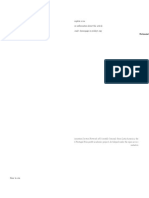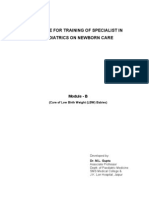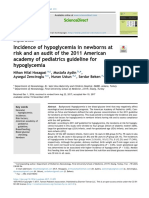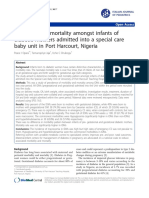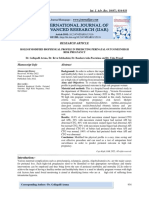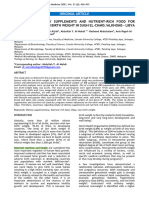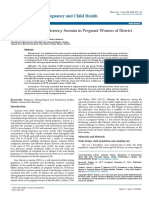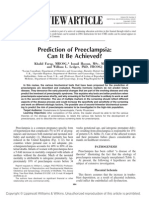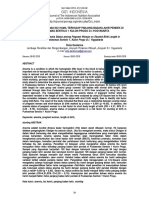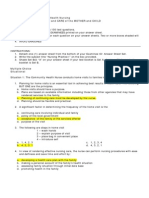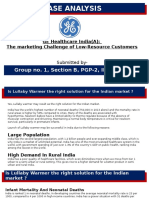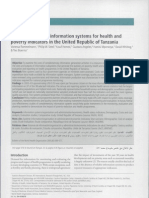Professional Documents
Culture Documents
Martial of Hypotrophe To Lubumbashi Factors Maternal Associated With Neonatal Hypoferritinemia
Original Title
Copyright
Available Formats
Share this document
Did you find this document useful?
Is this content inappropriate?
Report this DocumentCopyright:
Available Formats
Martial of Hypotrophe To Lubumbashi Factors Maternal Associated With Neonatal Hypoferritinemia
Copyright:
Available Formats
Volume 6, Issue 8, August – 2021 International Journal of Innovative Science and Research Technology
ISSN No:-2456-2165
Martial of Hypotrophe to Lubumbashi Factors
Maternal Associated with Neonatal Hypoferritinemia
Yaba A 1 * , Ngwe TMJ 2 , Assumani YN 1 , Tamubango KH , Kalenga MKP 2 , Mutombo MA 4 , Ngulu Nsasi 5 Wembonyama
OS 1 , Luboya NO 1
1. Department of Pediatrics, Faculty of Medicine, UNILU
2. Department of Gynecology-Obstetrics, Faculty of Medicine, UNILU
3. Department of Mother-Child Health, ISTM / Likasi
4. Department of Pediatrics , Faculty of Medicine, University of Mayi
5 . Faculty of Veterinary Medicine, UNILU
Abstract:- supplementation during pregnancy (OR7.03 [1.55-
31.90]).
Introduction
Hypotrophic newborns sometimes develop iron Conclusion
deficiency and neurological deficit. The objectives of the The present study shows that hypotrophic newborns do
present study are : to describe the socio-demographic not always have iron deficiency anemia. Iron
characteristics of mothers who have given birth to supplementation should not be systematic in these
hypotrophs and to determine their erythrocyte profile as newborns at birth but it will require an iron assessment
well as that of their newborns, to identify the maternal (hemoglobin and serum ferritin) beforehand.
factors associated with neonatal hypoferrinemia.
Keywords:- Low Birth Weight, Maternal Determinants,
Methodology Neonatal Hypoferritinemia, Lubumbashi, DRC.
U do cross-sectional descriptive study with an analytical
component, lasting 12 months was conducted in 10 I. INTRODUCTION
health facilities in Lubumbashi in the DRC. Mothers
who gave birth at term with hypotrophs without a Iron is an essential micronutrient, mainly to ensure the
history of hemorrhage or acute inflammatory disease transport of oxygen or to catalyze reactions of electron
during a single-fetal pregnancy were included in the transfer, nitrogen fixation , synthesis of deoxyribonucleic
study. The determination of maternal and fetal acid (DNA) and plays an important role in the
biochemical parameters were performed according to differentiation or the cell proliferation. The ferritin assay
the methods recommended by the International indirectly measures the amount of iron in the blood. A low
Federation Clinic Chemical (IFCC) and by the value of ferritin in serum is usually a good indicator of e
International Council of Standardization in the iron deficiency. In pregnant women, iron
Heamotology (ICSH) using the Automat AU480 deficiency p had t cause a risk of growth retardation
Beckman for ferritin and CRP and using the SYSMEX intrauterine (IUGR) and move to a low birth weight
KX21N automatic device for the determination of (LBW) , increasing the risk of morbidity and mor t neonatal
erythrocyte parameters. The data were analyzed using atilité short and long term [1–3] .
SPSS.23 software. In countries with resource s limited low birth weight is
a real health problem because the high cost of care in
Results neonatal units do not allow people to enjoy a better
The majority of mothers are 18 35 (54.4%) ; multiparous supported. Hence knowledge of the maternal factors
(42.5%), of low socio-economic level (62.7%), having associated with hypoferritinemia will make it possible to
had malaria (66.7%), consuming Kaolin (71.6%) without initiate treatment programs in order to reduce the rate of low
taking dewormer (76%) nor iron supplementation birth weight [4] .
(61.9%). They had anemia in 76.9% of cases
(Hb˂11gr%) with low ferritinemia (˂20μg / l) in 52% of In 2016 , the United Nations report states that
cases. Newborn small for gestational age had a normal worldwide 5.6 million children died before reaching their
hemoglobin (Hb≥13, 5 gr%) in 73.9% of cases and a low fifth birthday and 46% of them died within the first 28 days
férritnémie (˂60μg / L) in 32.8% of cases. The maternal of their lives . This rate is the lowest compared to previous
determinants of neonatal hypoferrtinemia are maternal years. Despite this progress, 60 million children will die
malaria (OR .113.43 [9.42-1364.53]), the birth interval before the age of 5 by 2030 if social inequalities are
less than 12 months (OR48.18 [6.37-364.57] ), not taking not reduced [5] .
dewormers (OR : 16.26 [2.04-129.50]) or iron
IJISRT21AUG136 www.ijisrt.com 962
Volume 6, Issue 8, August – 2021 International Journal of Innovative Science and Research Technology
ISSN No:-2456-2165
Low birth weight is implicated in 60 to 80% of - A nsure deliveries ;
neonatal deaths. The global prevalence of low birth weight - have a mother-child protection service (PMTCT) for the
is 15.5%, which represents about 20 million low birth management of HIV infection.
weight infants each year, 96.5% of them born in developing
countries. development [6.7] . II.2. Type of study:
This is a cross-sectional descriptive study with an analytical
T he neonatal and infant mortality rate can be component, covering the period from April 10, 2019 to
reduced by improving maternal care during May 12, 2020 .
pregnancy, childbirth and the care of low birth weight
infants. II.3. Study population and sampling
The study population consisted of 134 mother -
But in sub-Saharan Africa in general and the DRC in newborn couples . Our was made up exhaustively .
particular , joint efforts by the s Ministry s health public in
disponibilisant certain intervention packages to reduce II.3.1. Inclusion criteria
neonatal mortality is nt enough s. To this is added the We included in this study ; mother-newborn couples
widespread poverty th of the population, the low level of meeting the following criteria :
education, the diet unbalanced , some dietary restrictions - M era have consented freely to participate in the study and
related to certain customs and certain parasitic diseases . I s ay ant not presented a haemorrhage during pregnancy or
should be s ignaler that the esnsemble of these factors lead acute inflammatory disease ;
to deficiencies of some essential micronutrients , including - N ew-term infants , from a singleton pregnancy without
iron . The study by Beard et al . has shown that has iron transfusion history and showing no pathology acute
deficiency in the mother can conduir e in low birth inflammatory .
weight following the stress oxidative via placental
endothelial dysfunction and that these infants low birth II.3.2. Non-inclusion criteria
weight are often prone to iron deficiency [8] . As a result of The criteria for non-inclusion in this study are as follows :
this iron deficiency, newborns with low birth a) For the mother
weight can develop anemia due to lack of hemoglobin Mother with jaundice, sickle cell disease or thalassemia,
production ; of s disorders growth, development of cognitive caesarized , with pulmonary tuberculosis and on
function and motor by the defect of myelination of the antituberculosis , recently transfused (less than 4 months),
synthesis of monoamines and energy metabolism s glial on antimitotic, with large spleen and / or large liver,
cells and s neurons of the central nervous system . Thus iron febrile, with CRP (≥ 6 mg / l ).
deficiency in pregnant women in a context of
poverty worsens neonatal morbidity and mortality [9] . b) For the newborn
Newborn with jaundice , polymalformed, with infectious
The objectives of this work are : (1) to describe the stigma (sepsis), with fetal-maternal ABO and / or rh
socio-demographic characteristics of mothers who have incompatibility, recently transfused, born with depressed
given birth to hypotrophic newborns ; (2) determine the APGAR, under iron supplementation, ill at the time of
erythrocyte profile of mothers and hypotrophs, in particular selection , with CRP (≥ 6 mg / l) .
the mean globlary volume (MVV) and the mean corpuscular
hemoglobin concentration (C CMH), as well as the iron II.4 Parameters or study variables and definitions of
status of hypothrophs, in particular hemoglobin and serum concepts
ferritin ; (3) identify the maternal determinants associated II.4.1. For the mother :
with hypoferritinemia in hypotrophic neonates. a) Sociodemographic characteristics
- Age mother (years) and maternity risk ;
II. METHODOLOGY maternity at risk : ˂18 years and ˃35 years
m aternité safer : 18-35
II.1. Study place - Marital status (living alone e or living with a
The study was conducted in Lubumbashi , a partner) ;
city situated e to 1230 meters altitude in an - Activity daily (generating business income or non-
area Sickl anemia and malaria in the Democratic Republic regenerative revenue) ;
of Congo (DRC). Ten medical and health structures were - Socio- economic level :
selected in particular : the University Clinics of
Lubumbashi, the Jason Sendwe hospital, the HGR Kenya, The socio-economic level was assessed from the
the Sainte Bernadette maternity , the CS Mama wa Huruma, calculation of the poverty index as defined in a survey
the CS Mery center, the CS Kenya 1, the CS Imani Mgr carried out in DR Congo in 2001, the Multiple Indicator
Nsolotshi and AENEF. The selection of these medical and Cluster Survey (MICS2) [10] . It is a measure made up of
health facilities was made in a reasoned choice , taking into household characteristics: material of the floor, nature of the
account the criterion è res following : roof and walls of the dwelling , property belonging to the
- To welcome at least 300 new pregnant women per year in household, occupancy status of the dwelling; the availability
prenatal consultation and for prenatal care ; and duration of food reserves. This measurement of 36
- Be accessible to all social strata of the population ; points in total, allowed us to group the births into low socio-
IJISRT21AUG136 www.ijisrt.com 963
Volume 6, Issue 8, August – 2021 International Journal of Innovative Science and Research Technology
ISSN No:-2456-2165
economic levels (≤ 20 points), medium (21-24 points) and method. The CRP e st considered e as pathological if its
high (≥ 25 points) depending on the distribution . The DRC value is greater than e or equal to 6 mg / l.
is a country with limited resources, we avo purposes
described in this study of a cceptable socioeconomic levels II.4. 3 . S tatut martia l
m iddle or high in the analytical part . It was defined by the measurement of hemoglobin
and serum ferritin,
- Parity : nulliparous (Po), primiparous (P1), pauciparous a) In the mother
(P2-3) and multiparous (P≥4 ) [11] ; - Hemoglobin ( g / dl ) in pregnant women : a
- Nutritional status : the assessment indicator is MUAC rate of hemoglobin ≥11 (Normal) , from 8 to 10.9 ( Anemia
(MUAC) : poor nutritional status : MUAC <24 cm, good m oderate) , ˂8 ( a severe némie) [16]
nutritional status : MUAC ≥ 24 [9,12,13] - Serum Ferritin ( g / l ) : hypoférrinémie is considered a
- Level of studies : Low, if it is less than or equal to 8 years value of serum ferritin below 2 0 g / l [17] .
of studies (2 nd of the secondary cycle) ; Acceptable if it is - If serum ferritin between 12 - 20 µg /
over 8 years [14] . l : iron deficiency [17] ,
- If serum ferritin ˂ 12 µg / l : iron deficiency anemia
b) Maternal protection activities during pregnancy b) In the newborn
- Antimalarial prophylaxis : Intermittent presumptive - Rate hémogl obine ( g / dl ) : anemia is defined in the
treatment of malaria (IPT) and use of the long-lasting newborn by a hemoglobin of less than 13, 5 g /
impregnated mosquito net (LLIN) dl , [15] .
- Iron supplementation - Serum ferritin : µg / l. : hypoferritinemia in newborns is
- Parasite intestinal ( t reatment presumptive verminoses) : defined by a ferritin value of less than 60µg /
administration of mebendazole . l [17,18] .
If serum ferritin between 30 - 60 µg / l : iron deficiency,
c) Food and environmental habits If serum ferritin ˂ 30 µg / l : iron deficiency anemia
- Consumption of tea during pregnancy
- Coffee consumption during pregnancy The venous sample was taken in the morning at 7
- Alcohol consumption during pregnancy am in the fasting child for 8 hours at the level of the elbow
- Tobacco use during pregnancy fold, the tourniquet being loosely tightened . E t at the level
- Geophagy during pregnancy (consumption of of the umbilical vein in the newborn . The assay was carried
Kaolin) out according to the methods recommended
- Food prohibited during pregnancy by the International Fe de ration Clinic Ch e mi cal (IFCC)
and by the International Council of Standardization in
d) Pathologies during pregnancy Heamotology (ICSH). We used the AU480 Beckman coulter
- arterial hypertension chemical analyzer to measure ferritin and CRP. And the
- Diabetes SYSMEX KX21N hematological machine for the
- Malaria determination of erythrocyte markers. Serum ferritin assay
was coupled with CRP in order to rule out cases of acute
II.4. 2 . Erythrocyte Parameters and C-Reactive Protein inflammatory syndrome that could influence serum ferritin.
(CRP)
a) In the mother II.5 Data analysis
- Mean Globular Volume (MCV) [<80 μm 3 or fL Data processing was carried out using Epi Info 7.2.2.6
(femtolitre) : microcytic, 80-100 μm 3 or fL : normocytic, and SPSS version 23.0 software.
˃100 μm 3 or fL macrocytic [15]
- Mean Corpuscular Hemoglobin Concentration (CCMH) : g For the univariate analyzes , we determined the
/ dl (hypochromia <30, normochromia : 30-34, absolute and relative frequencies and the position (mean,
hyperchromia˃34) [15] median and mode) and dispersion parameters for the
- Reactive C protein (CRP) : the assay was carried out by the quantitative variables.
qualitative and semi-quantitative method. CRP is considered
pathological if its value is greater than or equal to 6 mg / Concerning the bivariate analyzes, we studied the
l association between some variables and their degree of
significance, the p-value, the threshold of which was set at
b) In the newborn 5%. Pearson's or Yates' corrected chi-square test was used
- Mean Corpuscular Volume (MCV) [<80 μ m 3 or fL or , failing that, the Fischer test.
(femtoliter) : in character microcyt area , 80-100 .mu.m 3 or
fL : normocyt area , ˃100 .mu.m 3 or fL to macrocytic The biases were eliminated by the regression logistics .
character [15] A insi , we carried out a multivariate analysis according to
- Mean Corpuscular Hemoglobin Concentration (CCMH) : g Mantel-Haenszel statistics . Reports of coastline (OR) and
/ dl (hypochromia <30, normochromia : 30-34, 95% confidence intervals to assess associations between 're
hyperchromia˃34) [15] independent and variable dependent s and the significance of
- Reactive C protein (CRP) : the assay was carried out by the factors associated with low fe rritine were also made . For
qualitative and semi-quantitative the adjustment, we retained the variables from the threshold
IJISRT21AUG136 www.ijisrt.com 964
Volume 6, Issue 8, August – 2021 International Journal of Innovative Science and Research Technology
ISSN No:-2456-2165
of p≤0.2 and the independent variables with significant and subject to approval of the Committee of Ethics of the
clinical significance were forced to integrate the model. University of Lubumbashi under approval number : UNILU
Variables with a strong significant correlation were pruned / EMC / 094 / 2018.
from the model.
II.6 Limits of the study
A decriminal analysis by the ROC curve (Receiver In the present study, only maternal and fetal extrinsic
Oparating Characteristic) or performance characteristic factors were exploited to investigate the relationship
curve made it possible to calculate the percentage or the between maternal predisposition , onset of low weight and
probability of these maternal determinants of causing low ferritin level. We did not realize the intrinsic analyzes
neonatal hypoferritinemia (serum ferritin ˂ 60 µg / l) in during pregnancy in pregnant (placental biopsy to search
hypotrophic newborns . for e pathology or dysfunction) or search
for pathology s congenital s related s fetus itself.
The protocol research of this is study was odopté by
the university clinics Department of Pediatrics Lubumbashi
III. RESULTS
III . 1. Features sociodemographic s mothers and low birth weight
Table I : Distribution of mothers s ccording characteristics socio demographic
Workforce (n = M ± SD or median
Sociodemographic characteristics Percentage
134)
Mother's age (year)
˂18 45 33.6
18-35 73 54 , 5
˃35 16 11.9
25.79 ± 6
Daily activity
Revenue generating activity 70 52.2
Non- revenue generating activity 64 47.8
Economic level
Low 84 62.7
Way 37 21.6
Raised 13 9.7
Mother's height (cm)
˂150 7 5, 3
≥150 127 94.7
163.7 ± 7.6
Parity
Primiparous 53 39.6
Pauciparous 24 17.9
Multiparous 57 42.5
3
MUAC (cm)
˂24 16 11.9
≥24 118 88.1
26.1 ± 2.2
Intergenesic space (months) Median
˂12 51 38.1
≥ 12 83 61.9
20
M : mean AND : standard deviation
Analysis of Table I shows that among mothers who gave birth to hypotrophs :
IJISRT21AUG136 www.ijisrt.com 965
Volume 6, Issue 8, August – 2021 International Journal of Innovative Science and Research Technology
ISSN No:-2456-2165
- 54 , 5 % are between 18 -35 years and 42.5% were multiparous ;
- 52.2% have a revenue-generating activity and 62.7% have a low socio-economic level ;
- 5, 3 % have a size less than 150 cm and 88.1% have an arm circumference greater than 24 cm
- 61.9% have an intergenerational space greater than or equal to 12 months.
III .2. Pathologies during pregnancy, eating habits, toxic exposures, antimalarial prophylaxis and low birth weight
Table II : Distribution of mothers according to pathologies during pregnancy, eating habits, toxic exposures, antimalarial
prophylaxis
Settings Effective Percentage
Iron supplementation
O ui 51 38.1
No one 83 61.9
Interference suppression (p ting s vermifuge s)
Yes 39 44.0
No 95 56.0
Malaria
Yes 88 65.7
No one 46 34.3
I nterdits food
Yes 33 24.6
No 101 75.4
Consumption of tea or the coffee
O ui 104 77.6
No one 30 22.4
Geophagy (consumption of Koali)
O ui 96 71.6
No one 38 28.4
CO2 exposure
( Cooking with wood / charcoal )
O ui 134 100.0
No one 0 0.0
Hypertension in pregnancy
Yes 8 6.0
No 126 94.0
Smoking
Yes 19 14,1
No 11 5 85,9
Antimalarial prophylaxis (IPT or LLIN)
Yes 5 3.7
No 129 96.3
The e Table II shows that 38.1 % of mothers received supplementation with iron during pregnancy. In 56.0% of cases , they
did not benefit from deworming and in 65.7 % of cases malaria was treated . In 24.6% of cases the observance of dietary
restrictions was observed . Tea consumption, geophagy was 77.6 % and 71.6 % of cases, respectively. In connection with the
notion of pressure on gro cy, smoking and to use of LLINs , the last eras were observed in 6.0 ; 1 4 , 1 % and 3.7% of cases.
IJISRT21AUG136 www.ijisrt.com 966
Volume 6, Issue 8, August – 2021 International Journal of Innovative Science and Research Technology
ISSN No:-2456-2165
III.3. P arameters erythrocyte maternal and ferritin
Table III : Distributions of mothers according to maternal erythrocyte parameters and ferritin
Maternal erythrocyte parameters and M ± ET or
Workforce (n = 134) Percentage
ferritin Median
Hemoglobin ( g / dl)
≥11 ( Normal ) 31 23.2
From 8 to 10.9 ( anemia m oderate ) 74 55.2
˂8 ( Severe anemia ) 29 21.6
10.0 ± 1
VGM ( μm 3 or fL (femtoliter)
<80 ( microcytic) 29 21.6
80-100 (normocytic) 88 65.7
˃100 (macrocytic) 17 12.7
85 ± 7.6
CCMH ( g / dl)
<30 ( hypochromic) 37 42.5
30-34 ( normochrome) 97 57.5
˃34 ( hyperchrome) - -
29.5 ± 1.6
Ferritin ( µg / l)
<20 (low or hypoferritinemia) 70 52.2
≥20 ( Normal ) 64 47.8
42
M : mean AND : standard deviation
By analyzing Table III , we find that the hemoglobin level was low in 76.9% of cases including 55.2 % moderate anemia and
21.6% severe anemia , the MCV low in 21.6. % of cases , low CCMH in 42.5 % of cases and low fever in 52.2%.
Hypotrophic newborn sex
47(n=63)
53(n=71)
Masculin Feminin
Figure 1 :
Distribution of hypotrophs by sex
It emerges from this figure that 71 hypotrohes or 53.0% were male . The sex ratio being 1.13 in favor of the male sex
IJISRT21AUG136 www.ijisrt.com 967
Volume 6, Issue 8, August – 2021 International Journal of Innovative Science and Research Technology
ISSN No:-2456-2165
III.4. Erythrocyte parameters of hypotrophs and ferritin
Table IV : Distributions of hypotrophs according to erythrocyte and ferritin parameters
M ± ET or
Erythrocyte and ferritin parameters Effective Percentage
Median
Hemoglobin ( g / dl)
<13.5 (anemia) 21 15.7
≥ 13.5 (normal) 113 84.3
16.9 ± 3
VGM ( μm 3 or fL (femtoliter)
<80 ( microcytic) 9 6.7
80-100 (normocytic) 93 69.4
˃100 (macrocytic) 32 23.9
97 ± 19
CCMH ( μm 3 or fL (femtoliter)
<30 ( hypochromic) 39 29.1
30-34 ( normochrome) 83 61.9
˃34 ( hyperchrome) 12 9
30 ± 3
Ferritin ( µg / l)
<60 (low or hypoferritinemia) 44 32.8
≥60 (Normal) 90 67.2
53
M : mean AND : standard deviation
Table V shows that in 15 , 7 % of cases the hemoglobin was less than the normal value should be anemia , with a
VGM normal in 69.4% of cases , a normal MCHC in 61.9% of cases and ferritin normal in 67.2% against 32.8 of cases of low
ferritinemia.
Schematic summary of the martial status of the hypotrophic newborn
Figure 2 : Schematic summary of the martial status of the hypotrophic newborn
IJISRT21AUG136 www.ijisrt.com 968
Volume 6, Issue 8, August – 2021 International Journal of Innovative Science and Research Technology
ISSN No:-2456-2165
It emerges from this diagram that iron deficiency anemia represented 2.24% of all hypotrophs, while iron deficiency without
anemia represented 24.63%. Shallow iron deficiency associated with low hemoglobinemia was present in 5.97% of cases and
normal ferritinemia associated with normal hemoglobin in 7.46% of cases. hypotrophs with normal hemoglobinemia and normal
ferritinemia constituted the majority of the sample, ie 59.70% of cases.
III . 5 . Maternal factors associated with neonatal hypoferritinaemia
The results of the test of association between the studied variables maternal and neonatal hypoferritinemia, in particular,
Odd 's ratio of gross, the 95% confidence intervals and p <0.05 are presented in the table below :
Table VI : Serum Fe rritin Levels in Newborns and Maternal Parameters
Settings Ferritin level
Maternal age (years) and maternity at risk not Low normal p OR [95% CI]
˂18 and ˃35 years ( Maternity at risk ) 61 11 ( 18 , 0 ) 50 (8 2.0 ) 0.002 0.3 [0.1-0.5]
18-35 years ( Maternity to lesser ) 73 3 3 (4 5 , 2 ) 40 (5 4 , 8 ) 0.000 1
Socio-economic level
Low or low 84 21 (25.0) 53 (75.0) 0.282 1.7 [0.6-3.6]
Acceptable ( m edium + high ) 50 23 (46.2) 27 (53.8) 1
MUAC (cm)
≥ 24 118 29 (24.6) 89 (75.4) 1
˂24 16 15 (93.8) 1 (6.3) 0.000 46.03 [5.82-363.7]
Intergenesic space (months)
≥ 12 83 16 (19.3) 67 (80.7) 0.000 1
˂12 51 28 (54.9) 23 (45.1) 5.09 [2.3-11.0]
Parity
Primiparous 53 8 (15.1) 45 (84.9) 0.002 1
Pauciparous 24 12 (50.0) 12 (50.0) 5.6 [1.8-16.6]
Multiparous 57 24 (42.1) 33 (57.9) 4.0 [1.6-10.2]
Iron supplementation
Yes 51 14 (27.5) 37 (72.5) 1
No 83 30 (36.1) 53 (63.9) 0.298 1.4 [0.69-3.2]
Intestinal deworming (taking dewormers )
Yes 39 5 (12.8) 34 (87.2) 0.002 1
No 95 39 (41.1) 56 (58.9) 4.4 [1.7-13.2]
Malaria
Yes 88 27 (30.7) 61 (69.3) 0.462 1
No 46 17 (37.0) 29 (63.0) 0.75 [0.35-1.5]
Food prohibited
Yes 31 19 (61.3) 12 (38.7) 0.000 1
No 108 25 (24.3) 78 (75.7) 0.20 [0.08-0.47]
Consumption of tea or coffee 0.000
No 30 20 (66.7) 10 (33.3) 1
Yes 104 24 (23.1) 80 (76.9) 0.15 [0.06-0.36]
Geophagy (Kaolin Consumption) 0.000
No 38 22 (57.9) 16 (42.1) 1
Yes 96 22 (22.9) 74 (77.1) 0.21 [0.09-0.48]
Hypertension during pregnancy 0.626
IJISRT21AUG136 www.ijisrt.com 969
Volume 6, Issue 8, August – 2021 International Journal of Innovative Science and Research Technology
ISSN No:-2456-2165
No 126 42 (33.3) 84 (66.7) 1
Yes 8 2 (25.0) 6 (75.0) 0.66 [0.12-3.44]
Smoking 0.001
No 118 33 (28.0) 85 (72.0) 1
Yes 16 11 (68.8) 5 (31.3) 0.17 [0.05-0.54]
Anti-malaria prophylaxis (IPT and LLIN) 0.012
Yes 5 4 (80.0) 1 (20.0) 1
No 129 40 (31.0) 89 (69.0) 0.11 [0.05-0.54]
Table VI shows a statically significant
difference between the low ferritin level and maternal age ˂ III.7. P robability four determinants of maternal cause
18 and ˃35 ( OR : 0.3 [0.1-0.5] p a hypoferritinemia in nou calf born hypotroph es
= 0.002 ), the acceptable socio-economic level (OR 2.2 [1.0- A descriminante analysis curve ROC (Receiver
5.1] p = 0.004 and OR 3.5 [1.0-11] p = 0.032 ), MUAC less Oparating Characteristic) or performance characteristic
than 24 cm ( OR : 46 03 [5,82- 363.7] p = 0.000), curve allowed to calculate the percentage or proba bi lity of
the pauci parity (OR : 5.6 [1.8 to 16.6]) multiparity (OR : these maternal détermiants to cause a neonatal
4.0 [1.6 to 10, 2] p = 0.002), the birth interval less than 12 hypoferritinemia ( ferritin serum ˂ 60μg / l) in newborn born
months ( OR : 5.09 [2.3-11.0] p = 0.000), taking dewormer hypotrophic .
( OR : 4.4 [1.7- 13.2] p = 0.000), tea consumption and / or
coffee ( oR : 0.15 [from 0.06 to 0.36] p = 0.000), food
prohibited s during pregnancy ( oR : 0, 20 [0.08-0.47], p =
0.000), geophagy during pregnancy ( 0.21 [0.09-0.48] p =
0.000), and smoking during pregnancy ( OR : 0.17 [0.05-
0.54], p = 0.000).
III. 6 . Maternal determinants of neonatal
hypoferritinemia
The logistic regression model focused on maternal
variables for which univariate analysis showed an
association with neonatal hypoferritinemia. The TableA u
VII gives O dd ratio s adjusted, the 95% confidence
intervals and e p taken at the threshold of less than 0.05 for
the variables whose association with hypoferritinemia
persisted after logistic regression.
Table VII : D determinant s maternal of
hypoferritinemia among newborns hypotrophe
Maternal determinants OR [95% CI] p Figure 1 : ROC curve
Intergenesic space less than 12 48.18 [6.37- 0.000
months 364.57] Figure 1 shows that the percentage or the probability of the
Non- iron supplementation 7.03 [1.55- 0.011 4 maternal determinants of causing neonatal
31.90] hypoferritninemia is 84.5% (AUC : area below the curve =
Non-deworming (not taking 16.26 [2.04- 0.008 0.845 [0.776-0.914]) .
dewormers) 129.50]
Malaria 113.43 [9.42- 0.000 IV. DISCUSSION
1364.53]
VI.1. sociodemographic mothers
It appears from this table that after adjustment, the Age
association with neonatal hypoferritinemia some maternal Our study shows that in 54 , 5 % of cases, small for
variables has persisted . This is malaria (OR : 113.4 [ 9.429 - gestational age were born to mothers aged 18 -
1364.533 ]) which has increased the risk of 35 years. Tshinzobe et al. [19] found 69.9% in the same age
low serum ferritin level in the hypotroph by group . Mengesha et al. [20] found a higher proportion of
113, from the birth interval of less than 12 low birth weight newborns in the maternal age group over
months (OR : 48.185 [ 6.369 - 364.573 ]) that increased the 18 years, without this difference being statistically
risk by 48, of the non-decision- s worming significant. Some authors have not found a relationship
(OR : 16.260 [ 2.042 - 129.505 ]) that increased the risk by between maternal age and growth [21,22] .
16 and the non iron supplementation (OR : 7.037 [ 1,552 -
31,909 ]) which multiplied the risk by 7.
IJISRT21AUG136 www.ijisrt.com 970
Volume 6, Issue 8, August – 2021 International Journal of Innovative Science and Research Technology
ISSN No:-2456-2165
Maternal age of less than 20 years is commonly Parity
associated with low birth weight [14] . This observation In our study 42.5% of women who gave birth
has been made by several authors. El Bakki et to hypotrophs were multiparous. D at very
al [23] avai in t found a significant association between authors also found more than multiparous among the omen
maternal age less than 18 years and the small birth that gave rise to small for gestational age, but there is a
weight. And concluded that this result could be explained by statistically Association significant. [35.36]
the fact that these young pregnant women have not yet
completed their growth and that they use the large part of Kangulu et al. [24] just like Tshinzobe et
the nutritional intake for their own growth at the expense of al. [19] had found , unlike us, more first-time mothers who
fetal growth. were affected respectively 24.4 % of cases , and 40.8 % . All
had found a statistically significant link between primiparity
Kangulu et al. [24] with 42.2% of cases aged less than and the occurrence of low birth weight.
18 years , avai in t found that women aged less than 18 years
were 7.6 times more likely to have infants of low weight Kayasta et al had shown that multiparity was a risk
than older mothers . Moyambe et al. [25] , Frisangho et factor for low birth weight [37] .
al . [26] and Mafina-Mienandi et al. [27] also reported
young maternal age (less than 18 years) as a factor In addition, Wachamo et al in 2019 in hospitals in the
associated with IUGR. North Wello zone in Ethiopia reported that parity was not
the only risk factor for low birth weight [30] .
Daily activity or occupation and socio- economic level
In our study , 52.2% of women who gave birth Thus it is possible in our study that the multiparas
to hypotrophs had silver regenerating activity. In 62.7 % of presented other risk factors which were at the base of the
cases they had a low socio- economic level although they low weight of their children.
had a regenerative activity of revenues .
Inter-reproductive space
Several studies show nt than years the majority of In our study, 38.1% of mothers had a birth interval
cases, are newborns at term small for gestational of less than 12 months linked to
age are the mothers of low socioeconomic [9] . hypoferritinemia . Endalamaw et al , found that the risk of
giving birth to a low birth weight newborn was tripled each
Cer tain authors have also found that mothers without time the parturient had an birth interval less than 24
generating activity of revenues (without occupation) gave months (AOR = 2, 8; CI [1.4–4.2] ) [38] , Moyambe et
birth to the new- born low weight in the majority of al. T et al [25] came to the same conclusion for an birth
cases [28-30] . Moyambe et al. [25] and Karim et interval of less than 12 months.
al. [31] had found in their studies, that there is a significant
association between the low socio-economic level of the The rained share of studies show how consistent a
pregnant woman and the IUGR. Indeed, the low socio- period of time between pregnancies is associated with low
economic level is often the cause of a poor nutritional state birth weight [27,39] . Indeed, when the interval is short, that
which leads to IUGR [32] . is to say less than 18 months, the mother may not have had
time to replenish adequate reserves of nutrients and is at risk
Cut of experiencing more stress, which can influence
In our study 5.3% of mothers who gave birth to hypotrophs intrauterine growth. In addition, when the birth interval is
had a height of less than 150 cm. longer, that is to say more than 60 months, the risk of
The short stature of pregnant women is generally premature delivery and intrauterine growth retardation
recognized as a factor associated with fetal increases since the reproductive capacities of the mother
hypotrophy [21,33] . El Bakki et al [23] in his decline over the years. following a first pregnancy [40] .
study , had o bserve a combination significantly between the
size of the pregnant woman and small birth weight. The risk Moreover in the USA, Rawlings reported the
of hypotrophy is 6 times higher if the patient's height is less association with the inter-reproductive interval of less than 9
than 155 cm. Moyambe et al. [25] avai in t also observed a months [41] . In his study, he found that the shorter the
significant association between the size of the pregnant and inter-reproductive interval, the greater the risk of IUGR and,
IUGR. The risk of IUGR is twice as high if the pregnant consequently, the occurrence of a low birth weight
woman's height is less than 155 cm. Indeed, in a small child. The increased risk of PNP in this case would be due to
woman there is a decrease or a low cardiac systolic ejection the fragility of the maternal organism, which has not yet
volume which does not lead to a decrease in utero-placental replenished its reserves of micronutrients and vitamins
perfusion with a deficient transfer of nutrients from the necessary for the good progress of a new pregnancy [42] . In
pregnant woman to the fetus thus leading to IUGR. [25] . addition, the uterus has not yet completely regained its
position, shape and physiological state. The mother is also
Scott and Usher [34] had meanwhile found that this under stress, which can negatively influence intrauterine
factor is not sig nificativement associated with IUGR. growth .
IJISRT21AUG136 www.ijisrt.com 971
Volume 6, Issue 8, August – 2021 International Journal of Innovative Science and Research Technology
ISSN No:-2456-2165
MUAC Iron supplementation and taking vermifuge s
In our series, maternal MUAC greater than 24 cm was In 38.1 % of cases , the mothers are benefited from
observed in 88.1% of women who gave birth to hypotrophs . supplementation with iron do nt 6% in the third quarter
of the pregnancy. In 56.0% of cases , they did not
Moyambe et al. observed that MUAC was benefit from deworming . This result shows that in the
significantly related to IUGR in univariate analysis and the majority of cases , pregnant women do not
risk of IUGR was 2 times higher for MUAC less than 24 benefit from most of the intervention package provided for
cm [25] . C ette observed tion joined those of other studies in accordance with the refocused ANC standard. In our
including those of Ra m nakrishman [43] , and and Chabra study, the risk of low ferritin levels was multiplied by 4 if
Bhandari [44] . the mother had not taken dewormer ( OR : 4.4 [ 1.7-
13.2 ] p = 0, 000).
It is possible to be in good nutritional status and to be
iron deficient as our results on maternal serum ferritin levels According to McCarthy et al , the use of iron, with or
show. And the impact of maternal iron deficiency on birth without folic acid, led to a 50% reduction in the risk of
weight is clearly documented at these [8,45,46] . anemia in the third trimester or at childbirth [50] .
If x e Newborn The importance of overall maternal health and lifestyle
D -year 53.0% of cases , the male sex were small for for neonatal iron status was emphasized. Public health
gestational age in our series . Tshotetsi et al as Tshinzobe et policies and health promotion interventions for women of
al avai in t reported a similar result [19,47] . Moyambe et childbearing age are needed along with the promotion of a
al. also found the male sex, but no association was healthy lifestyle among young women, essential to protect
found between the sex of the newborn and the low weight generations [50] .
of [25] .
Some authors noted in their study s , girls représentaien t the Martial status of the mother
majority of newborns of low weight birth [48,49] . Hemoglobin
Our study shows that the mothers are giving
VI.3. Pathologies during pregnancy, eating habits, toxic birth of small for gestational age ed was anemic in
exposures, prophylaxis activities 76.9% of cases with 55, 2% of moderate anemia and 21.6%
High blood pressure during the pregnancy of severe anemia . Moyambe et al. [25] avai in t observed
Our study shows that 6.0% of mothers who gave birth that maternal anemia was significantly associated with u n
to hypotrophs were hypertentensive. Our results showed intrauterine growth retardation Ute rine (p = 0.02) .
hypertension due to pregnancy in 6.0% of
cases . Hypertension in pregnant women is a known cause On the other hand, Kanya et al. [51] , Alwan et
of IUGR [21,22,33] . Hypertension causes a reduction in the al [52] found that maternal anemia was not associated e to
maternal blood supply to the placenta, by a decrease in intrauterine growth retardation.
uteroplacental flow and this decrease disrupts exchanges
thus causing intrauterine growth retardation. Moyambe et Ferritin
al. T [25] with 19.5% of cases , found that there is a We observed in our study that 52.2% of mothers had
significant association between arterial hypertension serum hypoferritemia (˂20 μg / l) . N ur result is similar to
and IUGR (p = 0.02). The risk for a pregnant hypertensive that of Agarwal et al [53] . who have observed in their series
woman to have a fetus with IUGR is twice as high as for a that e maternal hypoferrinémie was not significantly
non-hypertensive pregnant woman (OR = 2.44). associated with low birth weight . He explains this finding
by the fact that the a concentrate ion maternal ferritin
El Bakki et al. , Pusdekar et al avai in t also observed NCI laughing th to 12 g / l is the threshold likely below
that arterial hypertension in pregnant women was which fetal accretion ferritin is affected.
significantly associated with the occurrence of low birth
weight [23,49] . Kanya et al. has vaient , by con be ,
found ferritin normal (40 +/- 67 ug / l) in the majo women
P aludism who gave birth rity of small for gestational age p = 0.4
In our series , 65.7% of the mothers had malaria insignificant [51] .
(thick gout) . In areas of endemic transmission, malaria
during pregnancy is a common cause of maternal anemia Martial status of the newborn
and low birth weight. There is a considerable interaction
between maternal malaria and anemia in their effects on Hemoglobin
birth weight [21] . Moyambe et al. [25] had found that the We observed in our study that in 84.3% of cases the
risk of IUGR is 2 times higher in a pregnant malaria than in hemoglobin of hypotrophs was normal (13.5-21 g%) . Our
the non-malarious (OR = 1.95). result is similar to that of Mac Queen [54] had
found normal hemoglobin in her series .
It is now clearly established that malaria during pregnancy is
a risk factor for low birth weight [40] .
IJISRT21AUG136 www.ijisrt.com 972
Volume 6, Issue 8, August – 2021 International Journal of Innovative Science and Research Technology
ISSN No:-2456-2165
Kanya et al [51] t out as Jansson [55] reported an We would like to thank the head of the “ Dee
e insignificant levation of h e mog Lobine mie ch ez infants service ” laboratory for facilitating the chemical analyzes of
small for gestational age. the samples.
Competing conflicts of interest
Ferritin None declared
In our series , neonatal serum ferritin was low in 32.8% of
cases including 8.21% iron deficiency anemia and 24.63% Contributions from the authors
iron deficiency without anemia. Mac Queen et All authors have read and approved the final version of the
al. [54] and Kanya manuscript.
M et al. [51] avai in t also very oved ferritin crumb 11 g / L
in infants small for gestational age . REFERENCES
Agarwal et al. [53] avai in t found for their low ferritin [1]. Wick M, Pinggera W, Lehmann P. Clinical aspects and
levels but was not significantly associated with low birth laboratory: iron metabolism, anemias: concepts in the
weight in 2.3% of cases . Low birth weight is often anemias of malignancies and renal and rheumatoid
associated with deficiency [56] diseases. 6th, rev.updated ed ed. Wien; New York:
Springer; 2011. 196 p.
Maternal determinants of neonatal low ferritin [2]. Gaw A, editor. Clinical biochemistry: an illustrated
In our study, the maternal determinants of hypoferritinemia color text. 5th ed. Edinburgh: Churchill Livingstone /
are maternal malaria (OR : 113.4 [ 9.429 - 1364.533 ]) Elsevier; 2013. 187 p.
which increased the risk of low serum ferritin level [3]. Rodwell VW, Bender DA, Botham KM, Kennelly PJ,
in hypotrophs by 113, from space intergenesic less than 2 Weil PA. Harper's illustrated
years (OR : 48.185 [ 6.369 - 364.573 ]) that increased the biochemistry. 2018.
risk by 48, from not taking worming (OR : 16.260 [ 2.042 - [4]. El Bakkali M, Azzouzi Y, Khadmaoui A, Ouaaziz NA,
129.505 ]) that increased the risk by 16 and non Arfaoui A. Risk factors associated with the occurrence
supplementation iron (OR : 7.037 [ 1.552 - 31.909 ]) which of hypotrophy in the maternity ward of the Chérif
multiplied the risk by 7. Idrissi hospital in the Gharb Chrarda Bni Hssen region
The probability for these four maternal determinants of (Morocco ) / [Risk factors associated with the
causing neonatal hypoferritinemia is 84.5% (AUC according occurrence of low birth weight at the maternity
to the ROC curve = 0.845) . hospital Sharif Idrissi in the region of Gharb Chrarda
Bni Hssen (Morocco)]. Int J Innov Appl Stud. 2014; 7
Several authors have studied the link between the (3): 868.
status martia the breast and iron status neonatal to see their [5]. Hug L, Alexander M, You D, Alkema L. National,
degree ed association. Thus, some have argued that neonatal regional, and global levels and trends in neonatal
martial status was not influenced by any maternal mortality between 1990 and 2017, with scenario-based
parameters . Others have found a link between maternal projections to 2030: a systematic analysis. Lancet Glob
martial status and neonatal martial status [18] . Health. Jun 2019; 7 (6): e710-20.
[6]. Nahar N, Afroza S, Hossain M. Incidence of low birth
V. CONCLUSION weight in three selected communities of
Bangladesh. Bangladesh Med Res Counc Bull. 1998
The present study shows Aug; 24 (2): 49-54.
that the majority of mothers who gave birth to hypotrophs [7]. Krasovec K, Anderson MA, United States,
are aged 18 to 35 , multiparous, of low socio-economic editors. Maternal nutrition and pregnancy outcomes:
level , having had malaria, consuming Kaolin , without anthropometric assessment. Washington, DC: Pan
taking dewormer or iron supplementation . American Health Organization, Pan American Sanitary
Bureau, Regional Office of the World Health
hypotrophic newborns have a normal hemoglobin level Organization; 1991. 214 p. (Scientific
for the most part, on the other hand the 20 do not always publication).
have iron deficiency anemia. Iron supplementation should [8]. Beard J. Recent evidence from human and animal
not be systematic in these newborns at birth but it will studies regarding iron status and infant development. J
require an iron assessment (hemoglobin and serum Nutr. 2007 Feb; 137 (2): 524S-530S.
ferritin) beforehand. [9]. Meda N, Soula G, Dabis F, Cousens S, Some A,
Mertens T, et al. Risk factors for prematurity and
The present study shows that low birth weight intrauterine growth retardation in Burkina Faso. Rev
is linked to neonatal hypoferritinemia which thus reflects Epidemiology Public Health. 1995; 43 (3): 215–
iron deficiency anemia. The maternal determinants of this 224.
hypoferritinemia are malaria, the birth space less than 12 [10]. Congo, Dem. Rep. - Multiple Indicator Survey 2001,
months, intestinal parasitosis and no iron supplementation National Survey on the Situation of Children and
during pregnancy. Women [Internet]. [cited June 7, 2021]. Available at:
Thanks https://microdata.worldbank.org/index.php/catalog/682
IJISRT21AUG136 www.ijisrt.com 973
Volume 6, Issue 8, August – 2021 International Journal of Innovative Science and Research Technology
ISSN No:-2456-2165
[11]. Karim E, Mascie-Taylor CG. The association between [24]. Kangulu IB, Umba EKN, Nzaji MK, Kayamba
birthweight, sociodemographic variables and maternal PKM. Risk factors for low birth weight in semi-rural
anthropometry in an urban sample from Dhaka, areas of Kamina, Democratic Republic of Congo. Pan
Bangladesh. Ann Hum Biol. 1997 Oct; 24 (5): 387- Afr Med J [Internet]. March 20, 2014 [cited May 17,
401. 2021]; 17. Available at:
[12]. Elshibly EM, Schmalisch G. The effect of maternal https://www.ncbi.nlm.nih.gov/pmc/articles/PMC41631
anthropometric characteristics and social factors on 83/
gestational age and birth weight in Sudanese newborn [25]. Moyambe JNT, Bernard P, Khang'Mate F, Nkoy
infants. BMC Public Health. 2008 Jul 18; 8: 244. AMTA, Mukalenge FC, Makanda D, et al. Study of
[13]. Bourrillon A, Brémond-Gignac D. Pediatrics for the risk factors for intrauterine growth retardation in
practitioner. Elsevier; 2011. Lubumbashi. Pan Afr Med J. 2013; 14 (1).
[14]. Wharton B. Causes of hypotrophies in developing [26]. Frisancho AR, Matos J, Leonard WR, Yaroch
countries. Ann Nestlé Intra-Uterine Growth LA. Developmental and nutritional determinants of
Retardation Ed Nestlé Nutr 18th Semin. 1990; 19– pregnancy outcome among teenagers. Am J Phys
21. Anthropol. 1985 Mar; 66 (3): 247-61.
[15]. ASSUMANI AMIRGE JEAN-LAMBERT LUBOYA [27]. Mafina-Mienandi MC, Ganga-Zandzou PS,
NUMBI, OSCAR. LUBUMBASHI NEWBORN Makoumbou P, Malonga H, Ekoundzola JR. Risk
HEMOGRAM. European university editions. Sl: factors for intrauterine growth retardation in Congo. J
UNIVERSITY EDITIONS E; 2019. 115 p. Obstetrics Gynecology Biol Reprod. 2002; 31 (5):
[16]. Kalenga M. Study of anemia and risk factors in a semi- 500–505.
urban population of Lubumbashi in the DRC [doctoral [28]. Tesema GA, Worku MG, Tessema ZT, Teshale AB,
thesis in public health]. [Liège]: University of Alem AZ, Yeshaw Y, et al. Prevalence and
Liège; 2003. determinants of severity levels of anemia among
[17]. Yaba A, Ngwe TMJ, Assumani YN, Tamubango KH, children aged 6–59 months in sub-Saharan Africa: A
Kalenga MKP, Mutombo MA, et al. Serum Ferritin multilevel ordinal logistic regression analysis. PLoS
and Iron Status of Mothers and Newborns in ONE [Internet]. 23 Apr 2021 [cited 7 May 2021]; 16
Lubumbashi in the DRC. OALib. 2020; 07 (11): 1- (4). Available at:
16. https://www.ncbi.nlm.nih.gov/pmc/articles/PMC80647
[18]. Shao J, Lou J, Rao R, Georgieff MK, Kaciroti N, Felt 43/
BT, et al. Maternal Serum Ferritin Concentration Is [29]. Wachamo TM, Bililign Yimer N, Bizuneh AD. Risk
Positively Associated with Newborn Iron Stores in factors for low birth weight in hospitals of North
Women with Low Ferritin Status in Late Pregnancy. J Wello zone, Ethiopia: A case-control study. PLoS
Nutr. 2012 Nov 1; 142 (11): 2004-9. ONE [Internet]. March 20, 2019 [cited May 18, 2021];
[19]. Tshinzobe JCK, Ngaya DK. Case-control study of 14 (3). Available at:
factors associated with low birth weight at the https://www.ncbi.nlm.nih.gov/pmc/articles/PMC64261
Kingasani Hospital Center, Kinshasa (Democratic 81/
Republic of Congo). Pan Afr Med J [Internet]. Jan 27, [30]. Karim E, Mascie-Taylor CGN. The association
2021 [cited May 17, 2021]; 38. Available at: between birthweight, sociodemographic variables and
https://www.ncbi.nlm.nih.gov/pmc/articles/PMC80356 maternal anthropometry in an urban sample from
83/ Dhaka, Bangladesh. Ann Hum Biol. 1997; 24 (5):
[20]. Mengesha HG, Wuneh AD, Weldearegawi B, 387–401.
Selvakumar DL. Low birth weight and macrosomia in [31]. Siala S, Jellouli K, Doghri T, Gaigi S. Nutrition of
Tigray, Northern Ethiopia: who are the mothers at pregnant women and weight of the child at birth. Tunis
risk? BMC Pediatr [Internet]. June 12, 2017 [cited Medical. 1990; 68 (6-7): 459–462.
May 18, 2021]; 17. Available at: [32]. Marini A, Vegni C. Risk factors associated with IUGR
https://www.ncbi.nlm.nih.gov/pmc/articles/PMC54691 in industrialized countries. Intra-Uterine Growth
41/ Retardation Vevey Nestlé Nutr. 1990; 22–24.
[21]. Dumont M, MANUEZ M. Study of the etiological [33]. Scott KE, Usher R. Fetal malnutrition: its incidence,
factors of fetal hypotrophy: about 600 observations. J causes, and effects. Am J Obstet Gynecol. 1966; 94
Obstetrics Gynecology Biol Reprod. 1985; 14 (4): (7): 951–963.
439–448. [34]. Bekela MB, Shimbre MS, Gebabo TF, Geta MB,
[22]. Kramer MS, Olivier M, McLean FH, Willis DM, Tonga AT, Zeleke EA, et al. Determinants of Low
Usher RH. Impact of intrauterine growth retardation Birth Weight among Newborns Delivered at Public
and body proportionality on fetal and neonatal Hospitals in Sidama Zone, South Ethiopia: Unmatched
outcome. Pediatrics. 1990; 86 (5): 707–713. Case-Control Study. J Pregnancy. 2020; 2020:
[23]. El Bakkali M, Khadmaoui A, Ait Ouaaziz N, Arfaoui 4675701.
A. Risk factors associated with the occurrence of low [35]. Siyoum M, Melese T. Factors associated with low
birth weight at the maternity hospital Sharif Idrissi in birth weight among babies born at Hawassa University
the region of Gharb Chrarda Bni Hssen (Morocco). Int Comprehensive Specialized Hospital, Hawassa,
J Innov Appl Stud. 2014 Aug 1; 7: 868-74. Ethiopia. Ital J Pediatr. 2019 Apr 11; 45 (1):
48.
IJISRT21AUG136 www.ijisrt.com 974
Volume 6, Issue 8, August – 2021 International Journal of Innovative Science and Research Technology
ISSN No:-2456-2165
[36]. Kayastha S, Tuladhar H. Study of low birth weight https://www.ncbi.nlm.nih.gov/pmc/articles/PMC79519
babies in Nepal Medical College. Nepal Med Coll J 05/
NMCJ. 2007; 9 (4): 266–269. [50]. Pusdekar YV, Patel AB, Kurhe KG, Bhargav SR,
[37]. Endalamaw A, Engeda EH, Ekubagewargies DT, Thorsten V, Garces A, et al. Rates and risk factors for
Belay GM, Tefera MA. Low birth weight and its preterm birth and low birthweight in the global
associated factors in Ethiopia: a systematic review and network sites in six low- and low middle-income
meta-analysis. Ital J Pediatr [Internet]. 26 Nov 2018 countries. Reprod Health [Internet]. Dec 17, 2020
[cited 18 May 2021]; 44. Available at: [cited May 7, 2021]; 17 (Suppl 3). Available at:
https://www.ncbi.nlm.nih.gov/pmc/articles/PMC62582 https://www.ncbi.nlm.nih.gov/pmc/articles/PMC77453
99/ 51/
[38]. Rawlings JS, Rawlings VB, Read JA. Prevalence of [51]. McCarthy EK, Kenny LC, Hourihane JOB, Irvine AD,
low birth weight and preterm delivery in relation to the Murray DM, Kiely ME. Impact of maternal, antenatal
interval between pregnancies among white and black and birth-associated factors on iron stores at birth: data
women. N Engl J Med. 1995; 332 (2): 69–74. from a prospective maternal-infant birth cohort. Eur J
[39]. . Clin Nutr. 2017 Jun; 71 (6): 782-7.
[40]. Awiti JO. A multilevel analysis of prenatal care and [52]. Mukhopadhyay K, Yadav RK, Kishore SS, Garewal G,
birth weight in Kenya. Health Econ Rev [Internet]. 23 Jain V, Narang A. Iron status at birth and at 4 weeks in
Nov 2014 [cited 18 May 2021]; 4. Available at: preterm-SGA infants in comparison with preterm and
https://www.ncbi.nlm.nih.gov/pmc/articles/PMC45020 term-AGA infants. J Matern Fetal Neonatal Med. 2012
77/ Aug 1; 25 (8): 1474-8.
[41]. . [53]. Alwan NA, Cade JE, McArdle HJ, Greenwood DC,
[42]. Rawlings JS, Rawlings VB, Read JA. Prevalence of Hayes HE, Simpson NAB. Maternal iron status in
low birth weight and preterm delivery in relation to the early pregnancy and birth outcomes: insights from the
interval between pregnancies among white and black Baby's Vascular health and Iron in Pregnancy
women. N Engl J Med. 1995; 332 (2): 69–74. study. Br J Nutr. 2015 Jun 28; 113 (12): 1985-
[43]. El Bakkali M, Azzouzi Y, Khadmaoui A, Ouaaziz NA, 92.
Arfaoui A. Risk factors associated with the occurrence [54]. Agarwal R, Virmani D, Jaipal M, Gupta S, Sankar MJ,
of hypotrophy in the maternity ward of the Chérif Bhatia S, et al. Iron stores in low and normal birth
Idrissi hospital in the Gharb Chrarda Bni Hssen region weight infants at birth and in early infancy. Indian J
(Morocco ) / [Risk factors associated with the Pediatr. 2014; 81 (3): 279–282.
occurrence of low birth weight at the maternity [55]. MacQueen BC, Christensen RD, Ward DM, Bennett
hospital Sharif Idrissi in the region of Gharb Chrarda ST, O'Brien EA, Sheffield MJ, et al. The iron status at
Bni Hssen (Morocco)]. Int J Innov Appl Stud. 2014; 7 birth of neonates with risk factors for developing iron
(3): 868. deficiency: a pilot study. J Perinatol. 2017; 37 (4):
[44]. Ramakrishnan U. Nutrition and low birth weight: from 436–440.
research to practice. Am J Clin Nutr. 2004; 79 (1): 17– [56]. Jansson L, Holmberg L, Ekman R. Medicinal iron to
21. low birth weight infants. Acta Paediatr. 1979; 68 (5):
[45]. Chhabra S, Bhandari V. Some medico-socio- 705–708.
demographic factors and intra-uterine growth [57]. Wang J, Liu Y, Zhao Q, Liu T, Zhou Z. A
retardation. J Indian Med Assoc. 1996; 94 (4): 127– Retrospective Case-Control Study of the Determinants
130. of Iron Deficiency Anemia in Infants in an Urban
[46]. Means RT. Iron Deficiency and Iron Deficiency Community in Shanghai, China Between 2010-
Anemia: Implications and Impact in Pregnancy, Fetal 2015. Med Sci Monit Int Med J Exp Clin Res. 2020 Jul
Development, and Early Childhood 1; 26: e921463.
Parameters. Nutrients. 2020 Feb 11; 12 (2).
[47]. Allen LH. Anemia and iron deficiency: effects on
pregnancy outcome. Am J Clin Nutr. 2000 May 1; 71
(5): 1280S-1284S.
[48]. Tshotetsi L, Dzikiti L, Hajison P, Feresu S. Maternal
factors contributing to low birth weight deliveries in
Tshwane District, South Africa. PLoS ONE
[Internet]. March 1, 2019 [cited May 18, 2021]; 14
(3). Available at:
https://www.ncbi.nlm.nih.gov/pmc/articles/PMC63969
15/
[49]. Tessema ZT, Tamirat KS, Teshale AB, Tesema
GA. Prevalence of low birth weight and its associated
factor at birth in Sub-Saharan Africa: A generalized
linear mixed model. PLoS ONE [Internet]. March 11,
2021 [cited May 7, 2021]; 16 (3). Available at:
IJISRT21AUG136 www.ijisrt.com 975
You might also like
- Contemporary Problems of Indian Society - A General Studies Project ReportDocument24 pagesContemporary Problems of Indian Society - A General Studies Project Reportkosei78% (9)
- About Canada: Health and IllnessDocument14 pagesAbout Canada: Health and IllnessFernwood Publishing0% (1)
- The DOH Unang Yakap CampaignDocument2 pagesThe DOH Unang Yakap CampaignjustggNo ratings yet
- PSM Ankit SunailDocument28 pagesPSM Ankit Sunailnaveen gunturi50% (6)
- Risk Factors For The Development of Refeeding Syndrome-Like Hypophosphatemia in Very Low Birth Weight InfantsDocument7 pagesRisk Factors For The Development of Refeeding Syndrome-Like Hypophosphatemia in Very Low Birth Weight InfantsIsabella María GantivarNo ratings yet
- Eneroth H, Persson L-Å, El Arifeen S, Ekström E-C. InfantDocument6 pagesEneroth H, Persson L-Å, El Arifeen S, Ekström E-C. Infantaflah alfaNo ratings yet
- ILIE RO PHD Thesis AbstractDocument13 pagesILIE RO PHD Thesis AbstractAnonymous eson90No ratings yet
- Anupama Sharma, Et AlDocument10 pagesAnupama Sharma, Et AlAGERI PUSHPALATHANo ratings yet
- Ijgo 14944Document9 pagesIjgo 14944onlydarkheartNo ratings yet
- Literature Review On Prevalence of Anemia in PregnancyDocument4 pagesLiterature Review On Prevalence of Anemia in Pregnancyc5pdd0qgNo ratings yet
- Kriteria Rawat IcuDocument6 pagesKriteria Rawat Icuriska sovinaNo ratings yet
- Knowledge Level and Determinants of Neonatal Jaundice A Cross-Sectional Study in The Effutu Municipality of GhanaDocument10 pagesKnowledge Level and Determinants of Neonatal Jaundice A Cross-Sectional Study in The Effutu Municipality of GhananicloverNo ratings yet
- Chand Yo 2015Document7 pagesChand Yo 2015Sakarias PanjaitanNo ratings yet
- Jemc V5i2 23384Document6 pagesJemc V5i2 23384Students CBUNo ratings yet
- Ijph 45 558 PDFDocument11 pagesIjph 45 558 PDFArifah Azizah ArifinNo ratings yet
- Iron de Ciency Anemia Pregnancy Outcomes With or Without IronDocument8 pagesIron de Ciency Anemia Pregnancy Outcomes With or Without IronDani KusumaNo ratings yet
- 2021 - Voerman - Ped Obesity - Associations of Maternal & Infant Metabolite Profiles With Fetal Growth & Odds Adverse OutcomesDocument11 pages2021 - Voerman - Ped Obesity - Associations of Maternal & Infant Metabolite Profiles With Fetal Growth & Odds Adverse OutcomespaletaNo ratings yet
- Determinants of Nutritional Anaemia in Children Less Than Five Years AgeDocument6 pagesDeterminants of Nutritional Anaemia in Children Less Than Five Years AgeBaiiqDelaYulianingtyasNo ratings yet
- Mplete Issue Ore Information About This Article: Nutrición HDocument13 pagesMplete Issue Ore Information About This Article: Nutrición HDwi AnjarssNo ratings yet
- Yuan2019 Article IronDeficiencyInLatePregnancyA PDFDocument11 pagesYuan2019 Article IronDeficiencyInLatePregnancyA PDFDekaraNo ratings yet
- Jurnal Reading ObygnDocument6 pagesJurnal Reading ObygnLimastani FebrianaNo ratings yet
- 33873-Article Text-121761-1-10-20170831Document6 pages33873-Article Text-121761-1-10-20170831AnggaNo ratings yet
- Prevalence of Anaemia in Pregnant Women of District Mardan: Original ArticleDocument5 pagesPrevalence of Anaemia in Pregnant Women of District Mardan: Original Articlevanessa patayonNo ratings yet
- Original Research Paper Clinical Research: Anemia in Pregnancy and Its Consequences, and Effect of Maternal EducationDocument2 pagesOriginal Research Paper Clinical Research: Anemia in Pregnancy and Its Consequences, and Effect of Maternal EducationfadilahNo ratings yet
- Care of Low Birth Weight (LBW) BabiesDocument44 pagesCare of Low Birth Weight (LBW) BabiesSubhajit Ghosh100% (1)
- Chapter: OneDocument44 pagesChapter: OneCare 101No ratings yet
- Association Between Maternal Characteristics and The Risk of Isolated Maternal HypothyroxinemiaDocument7 pagesAssociation Between Maternal Characteristics and The Risk of Isolated Maternal HypothyroxinemiaAndres GallegosNo ratings yet
- Original Research Paper Obstetrics & GynaecologyDocument4 pagesOriginal Research Paper Obstetrics & GynaecologyVogireddy SindhuNo ratings yet
- Nihms 1806846Document21 pagesNihms 1806846mynana 222No ratings yet
- Abebaw 2020Document10 pagesAbebaw 2020Eva SihalohoNo ratings yet
- Jurnal Rahman 2 PDFDocument7 pagesJurnal Rahman 2 PDFAlfu RafdiNo ratings yet
- Pharmaceutical Sciences: Anemia in Pregnancy A Cause of Low Neonatal Birth WeightDocument4 pagesPharmaceutical Sciences: Anemia in Pregnancy A Cause of Low Neonatal Birth WeightiajpsNo ratings yet
- Morbidity and Mortality Amongst Infants of Diabetic Mothers Admitted Into A Special Care Baby Unit in Port Harcourt, NigeriaDocument6 pagesMorbidity and Mortality Amongst Infants of Diabetic Mothers Admitted Into A Special Care Baby Unit in Port Harcourt, Nigeriavighnaharta Online ServicesNo ratings yet
- CHAPTERSDocument22 pagesCHAPTERSArchana SahuNo ratings yet
- 9 JurnalDocument83 pages9 JurnalWanda AndiniNo ratings yet
- Association of Maternal Diet, Micronutrient Status, and Milk VolumeDocument12 pagesAssociation of Maternal Diet, Micronutrient Status, and Milk Volumefkik unibNo ratings yet
- epidemiology-of-malnutrition-among-pregnant-women-and-associatedfactors-in-central-refit-valley-of-ethiopia-2016-2161-0509-1000222Document8 pagesepidemiology-of-malnutrition-among-pregnant-women-and-associatedfactors-in-central-refit-valley-of-ethiopia-2016-2161-0509-1000222tewoldeNo ratings yet
- Role of Modified Biophysical Profile in Predicting Perinatal Outcome in High Risk PregnancyDocument5 pagesRole of Modified Biophysical Profile in Predicting Perinatal Outcome in High Risk PregnancyIJAR JOURNALNo ratings yet
- Perinatal Iron Deficiency: Implications For Mothers and InfantsDocument6 pagesPerinatal Iron Deficiency: Implications For Mothers and InfantsKattia Bravo VillavicencioNo ratings yet
- Research Article: Longer Breastfeeding Associated With Childhood Anemia in Rural South-Eastern NigeriaDocument7 pagesResearch Article: Longer Breastfeeding Associated With Childhood Anemia in Rural South-Eastern NigeriaRayhand MubarakhNo ratings yet
- International Journal of Pharmaceutical Science Invention (IJPSI)Document4 pagesInternational Journal of Pharmaceutical Science Invention (IJPSI)inventionjournalsNo ratings yet
- Anaemia ProjectDocument96 pagesAnaemia ProjectSALIHU ISAHNo ratings yet
- Abed,+1114 Impacts+of+Dietary+Supplements+and+Nutrient Rich+Food+for+Pregnant+Women+on+Birth+Weight+in+Sugh+El Chmis Alkhoms+–+LiDocument8 pagesAbed,+1114 Impacts+of+Dietary+Supplements+and+Nutrient Rich+Food+for+Pregnant+Women+on+Birth+Weight+in+Sugh+El Chmis Alkhoms+–+LiLydia LuciusNo ratings yet
- Association of Severe Intrahepatic Cholestasis of Pregnancy With Adverse Pregnancy Outcomes: A Prospective Population-Based Case-Control StudyDocument10 pagesAssociation of Severe Intrahepatic Cholestasis of Pregnancy With Adverse Pregnancy Outcomes: A Prospective Population-Based Case-Control StudyFernán BacilioNo ratings yet
- Navigating The Clinical Landscape of Severe Acute Malnutrition in India's Pediatric DemographicDocument10 pagesNavigating The Clinical Landscape of Severe Acute Malnutrition in India's Pediatric DemographicInternational Journal of Innovative Science and Research TechnologyNo ratings yet
- Jurnal PrevalensiDocument5 pagesJurnal PrevalensiHumairah AnandaNo ratings yet
- Refeeding Syndrome in The Neonatal Intensive Care Unit: JPPT - State of The Art ReviewDocument12 pagesRefeeding Syndrome in The Neonatal Intensive Care Unit: JPPT - State of The Art ReviewbacchiocchipaoloNo ratings yet
- Prediction of Preeclampsia PDFDocument19 pagesPrediction of Preeclampsia PDFAlejandro FrancoNo ratings yet
- Protocol Poojitha CompletedDocument15 pagesProtocol Poojitha CompletedPranav SNo ratings yet
- Maternal Factors For Low Birth Weight BabiesDocument3 pagesMaternal Factors For Low Birth Weight BabiesjanetNo ratings yet
- Medip, IJCP-1336 ODocument7 pagesMedip, IJCP-1336 OAvianitaNo ratings yet
- Study of Influence of Antenatal, Intranatal and Neonatal Factors On NICU Admissions in A Tertiary Hospital in Marathwada Region, Maharashtra, IndiaDocument6 pagesStudy of Influence of Antenatal, Intranatal and Neonatal Factors On NICU Admissions in A Tertiary Hospital in Marathwada Region, Maharashtra, IndiaInternational Journal of Innovative Science and Research TechnologyNo ratings yet
- Devisaragi89,+8.+117 Article+Text 424 1 2 20210708 - KhairaniDocument8 pagesDevisaragi89,+8.+117 Article+Text 424 1 2 20210708 - Khairanisri widayatiNo ratings yet
- Tugas Inggris 3 Session 2Document221 pagesTugas Inggris 3 Session 2dinaNo ratings yet
- BAGUSDocument10 pagesBAGUSvicus251071No ratings yet
- Risk Factors For Kernicterus in Neonatal JaundiceDocument4 pagesRisk Factors For Kernicterus in Neonatal JaundicePusparasmi Mas Ayu SuprabhaNo ratings yet
- RJME - Oficial Article - 63 - 02 - 2022 - 357-367Document11 pagesRJME - Oficial Article - 63 - 02 - 2022 - 357-367mihail.boldeanuNo ratings yet
- Pregnancy Outcomes in Familial Hypercholesterolemia: Epidemiology and PreventionDocument10 pagesPregnancy Outcomes in Familial Hypercholesterolemia: Epidemiology and PreventionsenkonenNo ratings yet
- Ijpedi2021 5005365Document8 pagesIjpedi2021 5005365KimberlyjoycsolomonNo ratings yet
- Factor associated with LBW among newborn west ethiopiaDocument6 pagesFactor associated with LBW among newborn west ethiopiaLydia LuciusNo ratings yet
- IjgoDocument33 pagesIjgoInggrid OlyviaNo ratings yet
- Breast Milk As A Topical Eye Drop Reduces The Severity of ROP: A Randomized Placebo-Controlled TrialDocument15 pagesBreast Milk As A Topical Eye Drop Reduces The Severity of ROP: A Randomized Placebo-Controlled TrialJesica DiazNo ratings yet
- Global Landscape of Nutrition Challenges in Infants and ChildrenFrom EverandGlobal Landscape of Nutrition Challenges in Infants and ChildrenNo ratings yet
- Human Milk: Composition, Clinical Benefits and Future Opportunities: 90th Nestlé Nutrition Institute Workshop, Lausanne, October-November 2017From EverandHuman Milk: Composition, Clinical Benefits and Future Opportunities: 90th Nestlé Nutrition Institute Workshop, Lausanne, October-November 2017No ratings yet
- Diabetic Retinopathy Stage Detection Using CNN and Inception V3Document9 pagesDiabetic Retinopathy Stage Detection Using CNN and Inception V3International Journal of Innovative Science and Research TechnologyNo ratings yet
- Exploring the Molecular Docking Interactions between the Polyherbal Formulation Ibadhychooranam and Human Aldose Reductase Enzyme as a Novel Approach for Investigating its Potential Efficacy in Management of CataractDocument7 pagesExploring the Molecular Docking Interactions between the Polyherbal Formulation Ibadhychooranam and Human Aldose Reductase Enzyme as a Novel Approach for Investigating its Potential Efficacy in Management of CataractInternational Journal of Innovative Science and Research TechnologyNo ratings yet
- Investigating Factors Influencing Employee Absenteeism: A Case Study of Secondary Schools in MuscatDocument16 pagesInvestigating Factors Influencing Employee Absenteeism: A Case Study of Secondary Schools in MuscatInternational Journal of Innovative Science and Research TechnologyNo ratings yet
- An Analysis on Mental Health Issues among IndividualsDocument6 pagesAn Analysis on Mental Health Issues among IndividualsInternational Journal of Innovative Science and Research TechnologyNo ratings yet
- Harnessing Open Innovation for Translating Global Languages into Indian LanuagesDocument7 pagesHarnessing Open Innovation for Translating Global Languages into Indian LanuagesInternational Journal of Innovative Science and Research TechnologyNo ratings yet
- The Utilization of Date Palm (Phoenix dactylifera) Leaf Fiber as a Main Component in Making an Improvised Water FilterDocument11 pagesThe Utilization of Date Palm (Phoenix dactylifera) Leaf Fiber as a Main Component in Making an Improvised Water FilterInternational Journal of Innovative Science and Research TechnologyNo ratings yet
- Advancing Healthcare Predictions: Harnessing Machine Learning for Accurate Health Index PrognosisDocument8 pagesAdvancing Healthcare Predictions: Harnessing Machine Learning for Accurate Health Index PrognosisInternational Journal of Innovative Science and Research TechnologyNo ratings yet
- The Relationship between Teacher Reflective Practice and Students Engagement in the Public Elementary SchoolDocument31 pagesThe Relationship between Teacher Reflective Practice and Students Engagement in the Public Elementary SchoolInternational Journal of Innovative Science and Research TechnologyNo ratings yet
- The Making of Object Recognition Eyeglasses for the Visually Impaired using Image AIDocument6 pagesThe Making of Object Recognition Eyeglasses for the Visually Impaired using Image AIInternational Journal of Innovative Science and Research TechnologyNo ratings yet
- Design, Development and Evaluation of Methi-Shikakai Herbal ShampooDocument8 pagesDesign, Development and Evaluation of Methi-Shikakai Herbal ShampooInternational Journal of Innovative Science and Research Technology100% (3)
- Dense Wavelength Division Multiplexing (DWDM) in IT Networks: A Leap Beyond Synchronous Digital Hierarchy (SDH)Document2 pagesDense Wavelength Division Multiplexing (DWDM) in IT Networks: A Leap Beyond Synchronous Digital Hierarchy (SDH)International Journal of Innovative Science and Research TechnologyNo ratings yet
- Terracing as an Old-Style Scheme of Soil Water Preservation in Djingliya-Mandara Mountains- CameroonDocument14 pagesTerracing as an Old-Style Scheme of Soil Water Preservation in Djingliya-Mandara Mountains- CameroonInternational Journal of Innovative Science and Research TechnologyNo ratings yet
- The Impact of Digital Marketing Dimensions on Customer SatisfactionDocument6 pagesThe Impact of Digital Marketing Dimensions on Customer SatisfactionInternational Journal of Innovative Science and Research TechnologyNo ratings yet
- Formulation and Evaluation of Poly Herbal Body ScrubDocument6 pagesFormulation and Evaluation of Poly Herbal Body ScrubInternational Journal of Innovative Science and Research TechnologyNo ratings yet
- Electro-Optics Properties of Intact Cocoa Beans based on Near Infrared TechnologyDocument7 pagesElectro-Optics Properties of Intact Cocoa Beans based on Near Infrared TechnologyInternational Journal of Innovative Science and Research TechnologyNo ratings yet
- Comparatively Design and Analyze Elevated Rectangular Water Reservoir with and without Bracing for Different Stagging HeightDocument4 pagesComparatively Design and Analyze Elevated Rectangular Water Reservoir with and without Bracing for Different Stagging HeightInternational Journal of Innovative Science and Research TechnologyNo ratings yet
- Auto Encoder Driven Hybrid Pipelines for Image Deblurring using NAFNETDocument6 pagesAuto Encoder Driven Hybrid Pipelines for Image Deblurring using NAFNETInternational Journal of Innovative Science and Research TechnologyNo ratings yet
- Review of Biomechanics in Footwear Design and Development: An Exploration of Key Concepts and InnovationsDocument5 pagesReview of Biomechanics in Footwear Design and Development: An Exploration of Key Concepts and InnovationsInternational Journal of Innovative Science and Research TechnologyNo ratings yet
- A Survey of the Plastic Waste used in Paving BlocksDocument4 pagesA Survey of the Plastic Waste used in Paving BlocksInternational Journal of Innovative Science and Research TechnologyNo ratings yet
- Hepatic Portovenous Gas in a Young MaleDocument2 pagesHepatic Portovenous Gas in a Young MaleInternational Journal of Innovative Science and Research TechnologyNo ratings yet
- Explorning the Role of Machine Learning in Enhancing Cloud SecurityDocument5 pagesExplorning the Role of Machine Learning in Enhancing Cloud SecurityInternational Journal of Innovative Science and Research TechnologyNo ratings yet
- Cyberbullying: Legal and Ethical Implications, Challenges and Opportunities for Policy DevelopmentDocument7 pagesCyberbullying: Legal and Ethical Implications, Challenges and Opportunities for Policy DevelopmentInternational Journal of Innovative Science and Research TechnologyNo ratings yet
- Automatic Power Factor ControllerDocument4 pagesAutomatic Power Factor ControllerInternational Journal of Innovative Science and Research TechnologyNo ratings yet
- Navigating Digitalization: AHP Insights for SMEs' Strategic TransformationDocument11 pagesNavigating Digitalization: AHP Insights for SMEs' Strategic TransformationInternational Journal of Innovative Science and Research TechnologyNo ratings yet
- Studying the Situation and Proposing Some Basic Solutions to Improve Psychological Harmony Between Managerial Staff and Students of Medical Universities in Hanoi AreaDocument5 pagesStudying the Situation and Proposing Some Basic Solutions to Improve Psychological Harmony Between Managerial Staff and Students of Medical Universities in Hanoi AreaInternational Journal of Innovative Science and Research TechnologyNo ratings yet
- Mobile Distractions among Adolescents: Impact on Learning in the Aftermath of COVID-19 in IndiaDocument2 pagesMobile Distractions among Adolescents: Impact on Learning in the Aftermath of COVID-19 in IndiaInternational Journal of Innovative Science and Research TechnologyNo ratings yet
- A Review: Pink Eye Outbreak in IndiaDocument3 pagesA Review: Pink Eye Outbreak in IndiaInternational Journal of Innovative Science and Research TechnologyNo ratings yet
- Drug Dosage Control System Using Reinforcement LearningDocument8 pagesDrug Dosage Control System Using Reinforcement LearningInternational Journal of Innovative Science and Research TechnologyNo ratings yet
- The Effect of Time Variables as Predictors of Senior Secondary School Students' Mathematical Performance Department of Mathematics Education Freetown PolytechnicDocument7 pagesThe Effect of Time Variables as Predictors of Senior Secondary School Students' Mathematical Performance Department of Mathematics Education Freetown PolytechnicInternational Journal of Innovative Science and Research TechnologyNo ratings yet
- Formation of New Technology in Automated Highway System in Peripheral HighwayDocument6 pagesFormation of New Technology in Automated Highway System in Peripheral HighwayInternational Journal of Innovative Science and Research TechnologyNo ratings yet
- AMERICAN RED CROSS 2006 Project Design and ProposalDocument55 pagesAMERICAN RED CROSS 2006 Project Design and ProposalAleksandar BogdanovicNo ratings yet
- Filipino Women Issues and Trends: OduleDocument38 pagesFilipino Women Issues and Trends: OduleTUYA JOHNVICNo ratings yet
- Univ Que 3rd mbbs-1990-2016 PDFDocument19 pagesUniv Que 3rd mbbs-1990-2016 PDFSamyuktha NatarajanNo ratings yet
- Implementation Strategy of Primary Health Care in Ovia CommunitiesDocument7 pagesImplementation Strategy of Primary Health Care in Ovia CommunitiesPuttryNo ratings yet
- Introduction To The CARE Design, Monitoring and Evaluation StandardsDocument73 pagesIntroduction To The CARE Design, Monitoring and Evaluation StandardsDejan ŠešlijaNo ratings yet
- Bicol Region Nutrition Plan 2012-2016Document26 pagesBicol Region Nutrition Plan 2012-2016kaikaikai123No ratings yet
- CHN NotesDocument17 pagesCHN NotesJohnny Yao JrNo ratings yet
- Training of Trainer's ToT Manual On MPDSR v8 CompressedDocument88 pagesTraining of Trainer's ToT Manual On MPDSR v8 CompressedShahidul Islam ChowdhuryNo ratings yet
- Demographic Profile-1 Barangay MangagoyDocument12 pagesDemographic Profile-1 Barangay MangagoySammy CoderaNo ratings yet
- 01 FHSIS Clarificatory F1 Plus PresentationDocument59 pages01 FHSIS Clarificatory F1 Plus PresentationMARJORIE PALMITOSNo ratings yet
- BEmONC - Training ManualDocument263 pagesBEmONC - Training ManualdiribaNo ratings yet
- Primary Health Care PDFDocument60 pagesPrimary Health Care PDFNadia BarrosoNo ratings yet
- Nigeria OilDocument27 pagesNigeria Oilapi-449241416No ratings yet
- Underpopulation in CanadaDocument14 pagesUnderpopulation in CanadaRuth MpalaNo ratings yet
- Reproductive Health Strategic Plan 2007-2011Document109 pagesReproductive Health Strategic Plan 2007-2011Nana Adwoa Animah100% (2)
- Gutenberg's Printing Press Transformed Society Through Knowledge DisseminationDocument6 pagesGutenberg's Printing Press Transformed Society Through Knowledge DisseminationGilda Genive AriolaNo ratings yet
- Answer Key EXAM DRILL 1 - Community Health Nursing Nursing Practice Ii - CHN and Care of The Mother and ChildDocument11 pagesAnswer Key EXAM DRILL 1 - Community Health Nursing Nursing Practice Ii - CHN and Care of The Mother and Childbetiful100% (5)
- Case Analysis: Group No. 1, Section B, PGP-2, IIM IndoreDocument7 pagesCase Analysis: Group No. 1, Section B, PGP-2, IIM IndorePappu JoshiNo ratings yet
- MNCHN strategies to reduce maternal and neonatal mortalityDocument3 pagesMNCHN strategies to reduce maternal and neonatal mortalityrocs De GuzmanNo ratings yet
- District Human Development Report InsightsDocument213 pagesDistrict Human Development Report InsightsAkbar JanNo ratings yet
- Introduction To Maternity and Pediatric Nursing 8th Edition Leifer Test BankDocument25 pagesIntroduction To Maternity and Pediatric Nursing 8th Edition Leifer Test BankTraciLewispwng100% (59)
- Health Care Delivery SystemDocument40 pagesHealth Care Delivery SystemArianne Kamille Andes100% (1)
- Quality of life in Hong Kong from different perspectivesDocument5 pagesQuality of life in Hong Kong from different perspectivesBilly AuNo ratings yet
- Social & Preventive MedicineDocument12 pagesSocial & Preventive Medicinedrsumanthmmc100% (1)
- TanzaniaDocument10 pagesTanzaniahst939No ratings yet


















